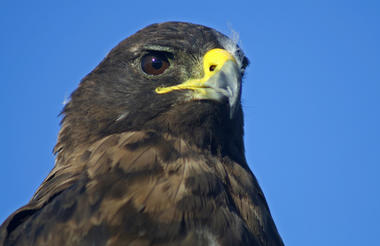When you arrive at Baltra Island, you’ll clear immigration and customs before being greeted by your Monserrat Yacht naturalist guide. They will escort you to the vessel, and then you'll set sail toward Dragon Hill for your first exploration of the Galapagos Islands.
Dragon Hill Excursion (PM)
Cerro Dragón (Dragon Hill) is a top birdwatching destination. You’ll take a short walk from the beach to a hypersaline lagoon, where you can spot pink flamingos, common stilts, pintail ducks, and other bird species. As you walk, you’ll pass through a Scalesia tree forest—an iconic species with only about 400 specimens remaining in the world.
Dragon Hill Snorkeling (PM)
After your land excursion, you’ll enjoy snorkeling off the beach along the rocky shoreline. This spot is perfect for swimming with green turtles, sharks, and rays.



Buccaneer Cove Panga Ride (AM)
Hop into the panga (or zodiac) and cruise alongside impressive cliffs and rock formations. This cove was once a pirate hideout where they stocked up on food and water. You’ll spot sea lions lounging on the beach and sea birds nesting in the area.
Buccaneer Cove Snorkeling (AM)
After the panga ride, take the opportunity to snorkel in the waters, where you can swim with playful sea lions and fur seals.
Puerto Egas Excursion (PM)
Explore the spectacular shoreline of Puerto Egas (also known as James Bay), home to many shorebirds and reptiles. The beach area is a bustling wildlife haven.
Puerto Egas Snorkeling (PM)
Jump into the water right off the beach to discover Puerto Egas' fascinating underwater world. Keep an eye out for rays, turtles, and reef sharks. After snorkeling, you'll visit the large tidal pool area, where marine iguanas and Sally Lightfoot crabs abound.



Vicente Roca Point Snorkeling and Panga Ride (AM)
Explore the rich marine life at Vicente Roca Point, known for its green turtles, sharks, and rays. Enjoy a dinghy ride along the coast to spot birds like Nazca boobies, blue-footed boobies, pelicans, and penguins.
Espinoza Point Excursion (PM)
Visit the pristine Fernandina Island, where you'll see tidal pools with sea life, marine iguana burrows, sea lion colonies, and the rare flightless cormorant.
Espinoza Point Snorkeling (PM)
Snorkel in one of the best spots in the Galápagos, swimming with marine iguanas, Galápagos penguins, and sea turtles.



Urbina Bay Excursion (AM)
Urbina Bay, formed in 1954 after a sea bottom uplift, offers stunning views of Alcedo volcano. On the trail, you may encounter wild Galapagos Giant Tortoises, Land Iguanas, and colonies of the flightless Galapagos Cormorant.
Urbina Bay Snorkeling (AM)
This spot is perfect for snorkeling with Galapagos Penguins and Marine Iguanas feeding underwater.
Tagus Cove Excursion (PM)
Tagus Cove, a historical site visited by Darwin, features graffiti left by past visitors. Here, you can spot seabirds like blue-footed boobies, Galapagos penguins, and sometimes finches or hawks. You'll also visit Darwin's Lake, a saltwater lake above sea level on the slopes of Darwin Volcano.
Tagus Cove Snorkeling (PM)
In the water, look out for sharks, turtles, sea stars, and colorful fish.



Breakfast
Lunch
Dinner
Black Turtle Cove Excursion (AM)
Explore the mangroves by panga to find rich marine wildlife between the fresh and salt waters. Keep any eye out for manta rays and sea turtles in this tranquil ecosystem. Whitetip reef sharks can also be seen gliding by.
Baltra Airport (AM)
Disembark at Baltra for flight back to Ecuador mainland



Breakfast








